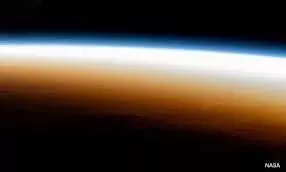
NASA shares stunning image of Earth's terminator - boundary between day and night
text_fieldsNASA has unveiled a mesmerizing image of Earth's terminator, the boundary that separates day from night.
Captured from the International Space Station (ISS) as it orbited 267 miles above the Pacific Ocean, the photograph reveals the awe-inspiring moment when a new day begins on our planet.
The ISS, which completes 16 orbits around Earth every 24 hours, provides a unique perspective to observe the terminator. This phenomenon occurs when the sun's rays strike the Earth's atmosphere, creating a clear division between the illuminated and darkened portions of the planet.
The terminator is visible as a thin, glowing line on the horizon, where the deep blue of the atmosphere meets the golden light of sunrise. It is the moving line that distinguishes day from night on Earth. This natural occurrence is a result of the planet's rotation and its position relative to the Sun.
Most locations on Earth experience the terminator twice daily - once at sunrise and once at sunset. However, regions near the North and South Poles, which endure extended periods of darkness or sunlight during winter and summer, experience the terminator differently.
The Earth's axis is tilted at an angle of 23.5 degrees, which causes varying amounts of sunlight to reach the Northern and Southern Hemispheres throughout the year. This axial tilt is responsible for the changing seasons, according to NASA.
During the equinoxes in March and September, the Earth's axis is aligned perpendicularly to its orbit, resulting in a straight terminator line. This alignment ensures that both hemispheres receive equal sunlight, leading to milder temperatures and more moderate weather.
In contrast, during the solstices in June and December, the Earth's tilt is at its maximum, causing the terminator to curve. This results in one hemisphere receiving more daylight than the other, leading to the longest and shortest days of the year.
The Earth's axial tilt also influences the distribution of sunlight, affecting the length of days and nights. As the terminator shifts, it impacts the environment and drives natural processes on the planet.
The March equinox typically falls around March 20 or 21, while the September equinox occurs around September 22 or 23. The June solstice happens around June 20 or 21, and the December solstice around December 21 or 22. These dates can vary slightly due to the Earth's elliptical orbit and the gravitational influence of other celestial bodies.






















